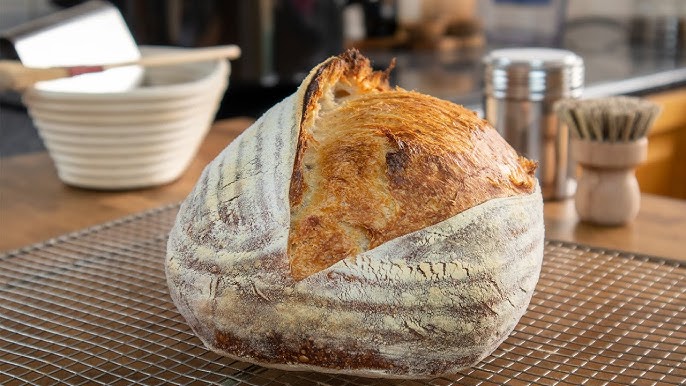Easy Sourdough Bread Recipe: Sourdough bread is a delightful mix of tradition, science, and art. Unlike commercial yeast-based bread, sourdough relies on natural fermentation to create its unique flavor and texture. It’s a bit like magic happening in your kitchen, but don’t worry—it’s easier than you think!
What Makes Sourdough Special?
Sourdough is special because it uses a natural starter—a mix of flour and water that captures wild yeast and bacteria from the air. This natural fermentation gives the bread a tangy flavor and chewy texture, setting it apart from other bread types.
Benefits of Baking Your Own Bread
Why bake sourdough at home? First, you control the ingredients—no preservatives or additives here. Plus, homemade sourdough tastes fresher, costs less than bakery options, and gives you a sense of accomplishment. It’s not just bread; it’s an experience.
Ingredients for Sourdough Bread
Sourdough has a simple ingredient list, but the quality of each ingredient matters.
Essential Ingredients
- Flour: All-purpose, bread flour, or whole wheat.
- Water: Filtered or spring water is best.
- Salt: Fine sea salt works well.
- Sourdough Starter: Your homemade or store-bought starter.
Choosing the Right Flour
The type of flour you use impacts your bread’s texture and flavor. Bread flour creates a chewy crumb, while whole wheat offers a denser, nuttier loaf. For beginners, start with unbleached all-purpose flour.
Tools You’ll Need
While sourdough is low on fancy equipment, a few tools can make your baking journey easier.
Must-Have Baking Equipment
- Mixing Bowls: For combining ingredients.
- Bench Scraper: To handle sticky dough.
- Dutch Oven or Baking Stone: Ensures even baking.
Optional Tools for Perfect Results
- Digital Kitchen Scale: Precision matters in baking.
- Thermometer: To check dough temperature.
- Banneton Basket: For shaping and proofing your dough.
How to Make Sourdough Bread
Step 1 – Preparing Your Starter
The sourdough starter is the heart of your bread. Think of it as your bread’s living, breathing engine.
What is a Sourdough Starter?
A sourdough starter is a mix of flour and water that ferments over time, developing the natural yeast and bacteria needed to leaven the bread. It’s what gives sourdough its unique taste and airy structure.
How to Feed and Maintain Your Starter
- Remove a portion of your starter (called “discard”).
- Add equal parts flour and water (by weight) to the remaining starter.
- Mix well, cover loosely, and let it sit at room temperature until bubbly.
Keep your starter fed daily if kept at room temperature or weekly if stored in the fridge.
Step 2 – Mixing the Dough
Once your starter is active and bubbly, it’s time to mix your dough.
Combining Ingredients
In a large bowl, mix:
- 500g flour
- 350g water (hold back 25g for later)
- 100g active starter
- 10g salt
Stir until combined into a shaggy dough.
Hydration Levels Explained
Hydration refers to the water-to-flour ratio in your dough. Higher hydration (above 75%) creates open crumbs but can be trickier to handle. Beginners can start with 70-75% hydration for manageable dough.
Step 3 – First Rise (Bulk Fermentation)
The bulk fermentation stage is where the magic of sourdough truly begins. During this time, your dough will develop structure and flavor as the fermentation process takes place.
Ideal Conditions for Fermentation
Bulk fermentation works best at a temperature between 75°F and 82°F (24°C to 28°C). If your kitchen is cooler, you can extend the fermentation time, or use a warm spot like the inside of an oven with the light on.
Cover your bowl with a damp towel or plastic wrap to prevent the dough from drying out.
Folding and Stretching Techniques
Every 30-45 minutes during bulk fermentation, perform a series of folds and stretches:
- Wet your hands to prevent sticking.
- Gently lift one side of the dough and fold it over to the opposite side.
- Rotate the bowl and repeat this process on all four sides.
This strengthens the dough’s gluten structure, making it more elastic and able to hold its shape during baking.
Step 4 – Shaping the Dough
After the bulk fermentation, it’s time to shape your dough into its final form.
Tips for Shaping Sourdough
- Turn your dough out onto a lightly floured surface.
- Pre-shape by gently folding the dough into a loose round.
- Let it rest for 20-30 minutes, covered, to relax.
- Final shape: Use your hands and a bench scraper to create tension on the dough surface by pulling it towards you gently.
Using a Banneton Basket
Place your shaped dough seam-side up in a floured banneton basket or a bowl lined with a floured kitchen towel. This supports the dough as it proofs, maintaining its shape and creating beautiful ridges on the crust.
Step 5 – Proofing Your Bread
Proofing allows your dough to rise one last time before baking.
Cold Proof vs. Room Temperature Proof
- Cold Proof: Place your dough in the refrigerator for 8-12 hours. This slows down fermentation and enhances the bread’s flavor.
- Room Temperature Proof: Let the dough sit at room temperature for 1-3 hours, depending on ambient conditions.
How to Test for Proper Proofing
Perform the “poke test” by gently pressing a floured finger into the dough. If the indentation springs back slowly but not completely, your dough is ready to bake.
Step 6 – Scoring and Baking
The final step brings your sourdough to life—literally!
Why Scoring is Important
Scoring (slashing the dough) helps control how your bread expands in the oven. Without scoring, the dough could burst unpredictably. Use a sharp razor or lame to make your cuts, aiming for about ¼ inch deep.
Baking Techniques for a Crisp Crust
- Preheat your oven to 475°F (245°C) with a Dutch oven or baking stone inside.
- Carefully transfer your dough into the hot Dutch oven or onto the baking stone.
- Add steam: Cover the Dutch oven with its lid or place a tray of water at the bottom of the oven.
Bake for 20 minutes covered, then another 20-25 minutes uncovered for a golden-brown crust.
Common Challenges and Troubleshooting
Even seasoned bakers encounter issues. Here’s how to address the most common ones.
Flat Loaves
A flat loaf could result from overproofing or insufficient gluten development. Adjust your proofing times or folding techniques.
Overproofing or Underproofing
Overproofed dough feels too loose and deflates easily, while underproofed dough resists shaping. Master the poke test to avoid these pitfalls.
Storing and Enjoying Your Sourdough Bread
Sourdough bread tastes best fresh, but proper storage can extend its life.
Keeping Bread Fresh
- Store in a paper bag or wrapped in a clean towel for up to 2 days.
- For longer storage, slice the bread and freeze it in airtight bags. Toast slices directly from the freezer.
Creative Ways to Use Sourdough
- Make croutons, bread pudding, or French toast with day-old bread.
- Pair fresh sourdough with butter, jam, or hearty soups.
Tips for Perfect Sourdough Every Time
Baking sourdough is a journey, not a destination.
Practice and Patience
Your first loaf might not be perfect, but every bake teaches you something. Keep experimenting and learning.
Experimenting with Flavors
Try adding seeds, herbs, or dried fruits for unique variations. Whole grain or rye flour also adds depth to the flavor.
Health Benefits of Sourdough Bread
Sourdough isn’t just delicious; it’s good for you too.
Digestive Benefits
The long fermentation process breaks down gluten and makes sourdough easier to digest, even for those with mild sensitivities.
Nutritional Profile
Sourdough has a lower glycemic index than most bread, meaning it’s less likely to spike blood sugar levels. Plus, it’s rich in probiotics and nutrients.
FAQs about Easy Sourdough Bread Recipe
1. What ingredients do I need for a basic sourdough bread?
To start with a basic sourdough bread, you’ll need sourdough starter, flour, water, and salt. That’s it! These ingredients combine to create a deliciously tangy loaf that’s both satisfying and versatile.
2. How long does it take to make sourdough bread?
The time to make sourdough bread varies, but you should plan for about 12 to 24 hours from start to finish. This includes time for the starter to activate, dough to ferment, and bread to bake. The long fermentation is crucial for that classic sourdough flavor and texture.
3. Do I need special equipment to bake sourdough bread?
While no special equipment is necessary, a few tools can make the process easier. These include a digital scale for measuring ingredients, a dough scraper to handle the sticky dough, and a Dutch oven to achieve a crispy crust.
4. Why is my sourdough bread so dense?
Dense sourdough bread can result from several factors: not enough fermentation time, a weak starter, or insufficient steam during baking. Make sure your starter is bubbly and active, and allow your dough to rise sufficiently.
5. Can I make sourdough bread without a starter?
Traditional sourdough bread relies on a starter for leavening, but you can create a ‘sourdough-like’ loaf using commercial yeast. However, you won’t achieve the same depth of flavor as bread made with a natural starter.
6. How do I store sourdough bread?
To keep your sourdough loaf fresh, store it cut-side down on a wooden board or in a bread box for up to 3 days. For longer storage, slice and freeze the bread for up to a month.
7. What are some common variations of sourdough bread?
Popular variations include adding ingredients like olives, nuts, seeds, or dried fruit to the dough. You can also experiment with different types of flour, such as whole wheat or rye, to change the flavor and texture of your bread.
8. Is sourdough bread healthier than regular bread?
Sourdough bread is often considered healthier due to its fermentation process, which can make nutrients more digestible and reduce the presence of antinutrients. Additionally, the lower phytic acid level in sourdough may increase mineral bioavailability.
Conclusion
Baking sourdough bread is an art that combines patience, practice, and a touch of science. With this step-by-step guide, you’re equipped to bake a loaf that’s not just bread but a testament to your effort and creativity. Now, roll up your sleeves and start baking!



